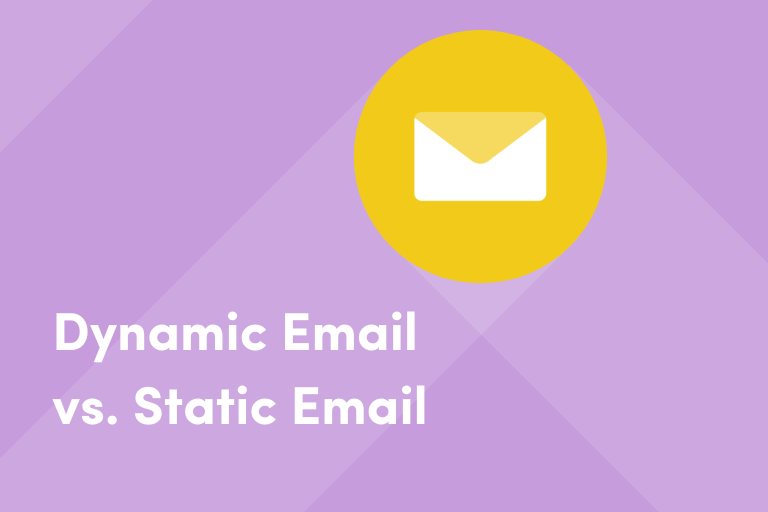In today’s digital marketing landscape, there are so many technologies, tactics, strategies, and channels brands can use to connect with customers—it can be overwhelming to determine which ones to use. Even if we break this down and look exclusively at email marketing, there are still options and choices to make. One of those choices is whether to employ static or dynamic emails. But before we dive into how you might choose between the two, let’s explore what each entails.
What Makes an Email Static, Versus Dynamic?
Let’s start with the simplest of the two—static emails. The “static” label generally means that a marketer loaded their content and distribution list into their email marketing platform and clicked the send button. All of the emails get sent at the same time and the content within the emails is the same for everyone receiving it. This is commonly referred to as batch-and-blast. In modern marketing circles, however, this tactic is generally frowned upon because it lacks personalization. But static emails do have their place, which we’ll dig into shortly.
Dynamic emails, on the other hand, deviate from the static approach in many ways but they can be broken down into two, primary categories:dynamic deployment and dynamic content.
Dynamic Deployment
Dynamic deployment means that it’s not just a blast, where all emails go out at the same time, at the push of a button. Instead, these emails can be triggered by an action that the customer takes, such as a cart abandonment or the usage of a product feature. When the customer completes an action that warrants a message, the marketing platform automatically sends out an email containing content based on the actions that they took.
Another method of dynamic deployment is where the marketer does actually press a button for a batch send but the email isn’t sent out immediately. Instead, the email send is delayed until a specific time in the future which aligns with the most optimal time for each individual customer to receive that email. This might be done for a reason as simple as ensuring that the email is going out at a specific time, in the customer’s time zone. For example, it might be set to go out at 10am on Tuesday morning, in the customer’s time zone.
A more sophisticated approach would be to leverage a feature like Iterable’s Send Time Optimization, where the platform leverages AI to calculate the best time to send the email based on each individual customer’s interaction history. For example, if the platform sees that a customer usually interacts with messages at 6:00 in the evening, it will send the email at that time.
In either of these kinds of deployments, no customer is receiving the emails at the same time, but rather when it’s most appropriate for the customer, making them dynamic email deployments.
Dynamic Content
When most marketers talk about dynamic emails, they’re usually talking about this second category—dynamic content.
Dynamic content is a tactic which utilizes customer data to customize specific sections within an email. This data can include demographics, purchase history, browsing behavior, or any relevant customer information. At send time, the email content adjusts automatically for each recipient, personalizing things like greetings, product recommendations, offers, links, calls-to-action, or even entire sections. For example, a dynamic email from a fashion retailer might showcase previously viewed items or other items of a similar style for returning customers, while displaying new arrivals for first-time subscribers.
The combination of dynamic deployment and dynamic content can be extraordinarily powerful as it personalizes every aspect of the email experience, for each individual customer, at scale. When you consider how much work—and the size of the team needed to do all of this manually, one send at a time for your entire active customer base—I’m sure you’ll agree that the ability to leverage dynamic emails is not only a game changer for personalized messaging but a massive force multiplier for your organization.
Dynamic Versus Static, Which is Better?
On the surface, a marketer might be tempted to lean towards using dynamic emails for every communication but there are situations where static emails might still be the best choice. So which one should you choose?
To arrive at the best answer, we’d want to ask ourselves a few questions.
- First, what is the purpose of the email? Is it truly for marketing?
- Is the goal to drive engagement, retention or revenue, or is it more transactional or support related?
- How urgent is it? Maybe it’s a support related blast that has to go out immediately or maybe it’s a transactional email that simply confirms a customer’s action.
- Last, but definitely not least, how good is our customer data? Is it current, accurate and complete—or is the quality of the data in question?
That might seem like a lot of questions to ask but they’re all important for determining whether a simple, static email will suffice or if it’s a good opportunity to leverage dynamic emails. So let’s break down these questions to get at the strategy behind them.
How Good is Your Customer Data?
Starting at the bottom, let’s look at what is arguably the most important question here: how good is your customer data?
If your organization is one of the rare few, who’s data governance is top notch, the data is clean, accurate, and made actionable within your martech stack, then you have a lot of flexibility in choosing the types of emails you want to send. If, however, your organization has some data issues in terms of completion, quality and availability, you may need to stick to static emails—at least until you can get your data ducks in a row.
The reason being is that dynamic emails rely entirely on quality customer data. For example, if you want to do a dynamic batch send, you’ll need to have accurate data on customer locale, time zone, etc. readily available in your sending platform. Without that data, it might as well just be a static batch deployment.
For dynamic content, the importance of quality data is even more important. You’ll need accurate and recent data for items such as demographics, purchase history, product usage, recent interactions, and more . This is vital because if you send dynamic content emails based on inaccurate data, it can create a disconnect with your customers.
Put yourself in the customers’ shoes and think about how you might feel if a brand that you’ve been doing business with for years sends you a marketing email using the wrong name, tells you to buy a product that you’ve recently purchased, or promotes products or services that clearly conflict with your interests. This can create a disconnect and make it feel that the brand doesn’t know you at all.
How Urgent is the Message and What’s the Goal?
Going backwards up the list, let’s look at the third and second questions. Assuming you have at least some of the most relevant customer data in an accurate and actionable state within your marketing automation platform, we’ll want to look at the other questions we covered above to decide if the emails should be static or dynamic.
Sometimes, simple is best. If your email is transactional or support related, you may want to just stick with the most expedient method and keep it static. For example, if the email is an urgent support related batch send, it probably needs to go out immediately, rather than an optimal time in the future. Also, you may want to keep the content of that email as simple and clean as possible, for a few reasons.
Firstly, to get it out the door quickly and ensure the primary message is clearly received and secondly, to avoid running afoul of any potential issues with anti-spam regulations relating to including promotional content within operational or transactional emails. That said, if you’re building out your templates well in advance of any of these urgent deployments, you might still include dynamic content blocks that contain helpful tips and tricks to drive engagement.
Tip: Consult your deliverability expert prior to adding anything remotely promotional to your transactional or operational emails.
What’s the Purpose?
Now, let’s go back to the first question, “What is the purpose of the email?” If marketing is the purpose of the email campaign, and your data is current, accurate and actionable, then you will absolutely want to leverage dynamic emails. Deployments should be as dynamic as they can be in order to improve your chances of customers opening your emails and you’ll want to lean heavily into using dynamic content.
You can personalize subject lines, use your customer’s name, and include text and imagery throughout the entire email that directly relate to your customer’s interests, buying history, product usage, browsing history, you name it. As long as you have the data for it, you can (and should) personalize the content based on that data.
Why is this so important? Because personalizing marketing messages with dynamic content shows customers that you truly know and care about them, which significantly increases the likelihood customers buying from you.
Elevate Your Email Marketing
In conclusion, while static emails still have their place for urgent transactional or support messages, leveraging dynamic email presents a powerful opportunity to elevate your email marketing strategy. By personalizing both deployment times and content based on customer data, you increase the likelihood of your messages resonating with each individual recipient. Remember, 71% of consumers expect personalization from brands and 76% get frustrated when they don’t see it. Dynamic email is an excellent way to ensure your emails are truly personalized.
To learn more about how Iterable can help you optimize your email campaigns, schedule a custom demo today.






























